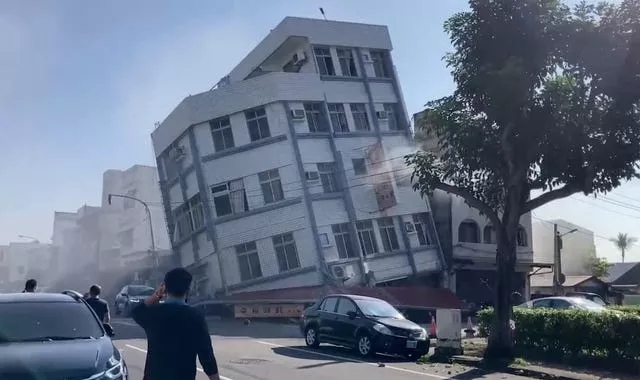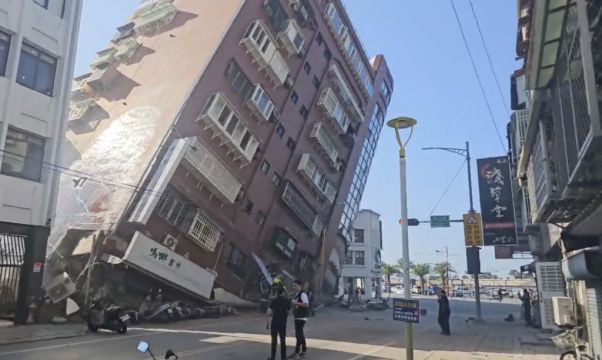A powerful earthquake has rocked the island of Taiwan, damaging buildings in a southern city and creating a tsunami that headed towards southern Japanese islands.
Taiwan’s earthquake monitoring agency said Wednesday morning’s earthquake was magnitude 7.2 on the Richter scale, while the US Geological Survey put it at 7.4.
A five-storey building in Taiwan’s Hualien appeared heavily damaged with the first floor collapsing and leaving the rest leaning at a 45-degree angle.
In the capital Taipei, tiles fell from older buildings and within some newer office complexes.

The earthquake struck at 7.58am with the epicentre about 11 miles south-south west of Hualien and 22 miles deep.
Train service was suspended across the island of 23 million people, as was subway service in Taipei, where a newly constructed above-ground line partially separated.
The national legislature, a converted school built before the Second World War, also had damage to walls and ceilings.
Wu Chien-fu, the head of Taiwan’s earthquake monitoring bureau, said effects were detected as far away as Kinmen, a Taiwanese-controlled island off the coast of China.
Multiple aftershocks were felt in Taipei in the hour after the initial quake.
Taipei resident Hsien-hsuen Keng said: “Earthquakes are a common occurrence, and I’ve grown accustomed to them. But today was the first time I was scared to tears by an earthquake. I was awakened by the earthquake. I had never felt such intense shaking before.”
She said her fifth-floor apartment shook so hard that “apart from earthquake drills in elementary school, this was the first time I had experienced such a situation”.
There was still no word on casualties from the epicentre near the city of Hualien, where a deadly quake in 2018 collapsed a historic hotel and other buildings.
The earthquake was felt in Shanghai and several provinces along China’s south-eastern coast, according to Chinese media.
China and Taiwan are about 100 miles apart. China issued no tsunami warnings for the Chinese mainland.
Residents of China’s Fujian province reported violent shaking, according to online outlet Jimu News.
One man told Jimu that the shaking awakened him and lasted about a minute.
In the Philippines, residents along the northern coast were told to evacuate to higher ground, but no major tsunami was reported about three hours after the quake.
Villagers in the provinces of Batanes, Cagayan, Ilocos Norte and Isabela were asked not to return to their homes until the tsunami alert was lifted, Teresito Bacolcol from the Philippine Institute of Volcanology and Seismology said.
Japan’s chief cabinet secretary Yoshimasa Hayashi said there has been no report of injury or damage in Japan.
He urged the residents in the Okinawa region to stay on high ground until all tsunami advisories are lifted.
He cautioned the people against disinformation and urged to stay calm and assist others.
The Japan Meteorological Agency had forecast a tsunami of up to three metres for the southern Japanese island group of Okinawa.

A 30-centimetre wave was detected on the coast of Yonaguni island about 15 minutes after the quake struck.
Japan’s Self Defence Force has sent planes into the area to gather information about the tsunami impact around the Okinawa region.
It is also preparing shelters for evacuees if necessary.
The Pacific Tsunami Warning Centre said there was no tsunami threat to Hawaii or Guam.
The quake was believed to be the biggest in Taiwan since one in 1999 caused extensive damage.
Taiwan lies along the Pacific ‘Ring of Fire’, the line of seismic faults encircling the Pacific Ocean where most of the world’s earthquakes occur.
Taiwan’s worst quake in recent years struck in 1999, with a magnitude of 7.7, causing 2,400 deaths, injuring around 100,000 and destroying thousands of buildings.







